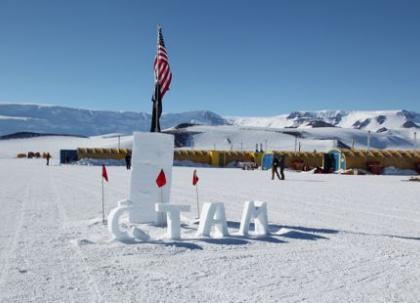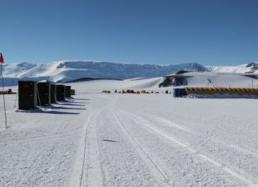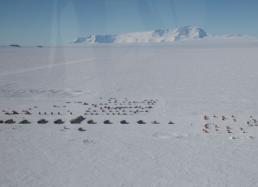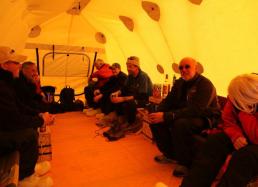5: The Final Destination—The Central Transantarctic Mountains
After eight days in McMurdo, we headed out yesterday for the final destination on our long journey. Prior to departure, we had snowmobile training and a number of errands to complete, including organizing and counting all the items and equipment that we were issued to make sure it matched our requests. We organized camp food for the remote camp that Christian Sidor’s team is planning, as well as for the rest of us, in case we go off-site, too.
Finally, all of our equipment had to be packed, weighed, and measured. Dimensions and weights are critical knowledge for the aircrews that transport our supplies and us—we even have to step on the luggage scale holding our carry-on bags and wearing our cold weather gear, which is mandatory for all air travel in Antarctica.
Our flight to the CTAM camp—the acronym stands for Central Transantarctic Mountains—was on board an LC-130 military transport, which has skis for landing gear. As on our flight from New Zealand, the rear half of the aircraft was filled with cargo strapped onto pallets, which in turn were lined up on rollers built into the aircraft floor. Our aircrew unloaded the cargo in what is known as a combat cargo drop—the rear ramp was opened while we were still taxiing down the ice runway, and the pallets rolled out behind the plane and directly onto the runway itself.
We stepped off the plane into bright sunshine and were surrounded by a stunning vista of snow-capped peaks and glaciers. A snow sculpture of the letters ‘CTAM’ greeted our arrival at the bustling camp (see above photo.) With its grid layout, tents and galleys in orderly rows, and helicopters and fixed-wing aircraft shuttling in and out throughout the day, the camp made a slightly military first impression, though this quickly dissipated (see Photos #1 and #2 below.) To watch our flight and landing at CTAM, check out my "Arriving in the Central Transantarctic Mountains" video.
The largest structure at CTAM is the galley, where we eat our meals and spend much of our time working when we return from the field (see Photo #3 below.) The ‘comms’ hut is the heart of the operations here, where all flights are coordinated. There are two science huts for storing equipment and for us to work in, and there’s even a wash tent, a luxury I did not expect. Because all the water we use here has to be mined as snow, we're limited to one shower a week (but to be honest, that's more regular hygiene than I get in most of my other field camps.)
Our first couple of days in the CTAM were dedicated to organizing field work. Nate and Peter Braddock flew out with survival bags and flags to stake out a route from the Cryolophosaurus excavation site on Mt. Kirkpatrick to a lower elevation in case bad weather forces us to overnight on the mountain. The rest of us were busy pulling together, weighing, and readying the more than 500 pounds of tools, generators, and other equipment needed for the excavation on Mt. Kirkpatrick. This was loaded onto the helicopter flight that headed out to pick up Nate and Peter in the afternoon.
After organizing the flight cargo, we set up a large 10x20-foot Arctic Oven tent that serves as our HQ. We had just finished, when Nate and Peter returned from Mt. Kirkpatrickwith good news—they'd found another site with fossil bones. Chris Sidor, Roger Smith, and Adam Huttenlocker had also been in the field looking at Middle Triassic (~235 MYA) rocks on Fremouw Peak. They, too, were successful in their first foray into the field, finding parts of amphibians and mammal-like reptiles. They'll be returning with a rock saw to extract these finds on Monday. The success of our first day of fieldwork was celebrated with drinks in our HQ tent, followed by a delicious dinner of ribs in the galley.
More soon,
Pete






